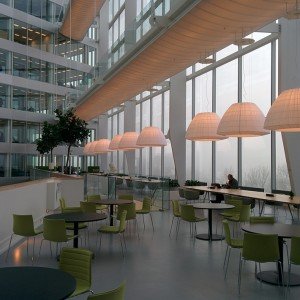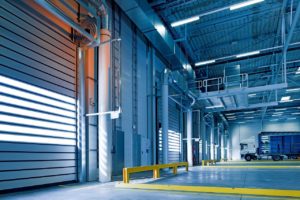HVAC (Heating, Ventilation and Air Conditioning) systems have become indispensable assets in commercial and industrial settings, playing a pivotal role in maintaining ambient conditions and ensuring operational efficiency.
However, like many sophisticated systems, they come with their own set of challenges. Shaun Evers, Managing Director of Stonegate, sheds light on the associated risks and the importance of effective gas detection.
Beyond comfort and convenience
 Modern commercial and industrial spaces are tightly controlled environments that owe much of their efficiency to HVAC systems.
Modern commercial and industrial spaces are tightly controlled environments that owe much of their efficiency to HVAC systems.
HVACs regulate temperature, control humidity and maintain air quality. As such, they offer more than just comfort and convenience, for instance, they play a crucial role in spaces like server rooms, where a slight change in temperature can lead to severe operational disruptions, or in cold storages, where precise conditions are vital to prevent product spoilage.
However, the underlying mechanics of these systems reveal a more complex picture. HVAC systems rely on refrigerant gases to control temperature and while these gases are integral to the system’s functioning, they raise a set of safety and environmental concerns that need to be addressed.
The hidden risks
In commercial and industrial settings, refrigerant gas leaks pose a number of potential risks. To start with, there’s the direct health risk posed to employees working in the vicinity. When these gases leak, their toxicity can cause a range of health issues, from minor irritations to severe respiratory conditions, especially if the exposure is prolonged.
Adding to the complexity is the architecture of these buildings. Unlike residential spaces, commercial and industrial buildings often feature expansive areas like cold storage units. In such areas, the fast-evaporating nature of these gases means they can quickly reach hazardous concentration levels, putting any personnel within that area at immediate risk.
 Moreover, because many of these spaces, especially in industrial settings, can be vast and isolated, there’s the added peril of personnel becoming trapped or working in areas where these gases can accumulate quickly. Without early detection or proper ventilation, these isolated spaces can quickly become dangerous or even fatal. In addition, some A2L refrigerants are flammable. Leaks, particularly in commercial and industrial premises, can present a serious risk of fire.
Moreover, because many of these spaces, especially in industrial settings, can be vast and isolated, there’s the added peril of personnel becoming trapped or working in areas where these gases can accumulate quickly. Without early detection or proper ventilation, these isolated spaces can quickly become dangerous or even fatal. In addition, some A2L refrigerants are flammable. Leaks, particularly in commercial and industrial premises, can present a serious risk of fire.
Beyond the immediate physical risks, there’s an energy and environmental dimension to consider. HVAC systems, especially in large commercial spaces, consume a significant amount of energy. Any inefficiency or leak can result in substantial energy wastage. Cold storage units, for example, rely on these systems to maintain their precise temperature requirements. A leak or a malfunction can disrupt this balance, leading not just to energy wastage but also potential product losses that cause operational and financial setbacks.
There are also significant environmental consequences resulting from refrigerant gas leaks. Many of these gases are potent greenhouse gases, with some having a Global Warming Potential (GWP) much higher than carbon dioxide. Frequent leaks inadvertently contribute to the environmental crisis and exacerbate the challenges of climate change.
Prioritising safety with advanced technology
Given the numerous challenges posed by refrigerant gas leaks and the stringent health and safety and environmental regulations now in place, businesses cannot afford to be complacent. Recognising the risks is only the first step; more important is the need to take proactive measures to detect leaks. This is where advanced gas detection technologies come into play.
Traditional methods of gas leak detection, which often rely on periodic checks, are no longer adequate. The average HVAC system leaks 20% of refrigeration gases every year and most leaks aren’t discovered until 60% of the gas has escaped. Given that many of these refrigerant gases are odourless and colourless, by the time a leak becomes noticeable, the damage in terms of health risks, energy wastage and environmental impact could already be significant.
Cutting-edge gas detection systems are now offering a more holistic and real-time solution to these challenges. Equipped with intelligent sensors, these systems can detect even minute concentrations of gases, ensuring early detection.
With real-time monitoring, businesses can ensure that any anomalies are detected and addressed promptly. These systems, besides sending out immediate alerts, often come with integrated safety features such as audio-visual alarms to ensure that personnel in the vicinity are immediately notified.
Overall, apart from keeping people safe, early detection systems can prevent irreversible equipment damage, hazardous environmental impacts, energy wastage and financial loss. What’s more, while gas detection systems are now mandatory in some environments, they help all businesses with HVAC systems remain compliant with current regulations and offer future-proofing for the stricter regulations on the horizon.
Approaches to managing the risks associated Musculoskeletal disorders
In this episode of the Safety & Health Podcast, we hear from Matt Birtles, Principal Ergonomics Consultant at HSE’s Science and Research Centre, about the different approaches to managing the risks associated with Musculoskeletal disorders.
Matt, an ergonomics and human factors expert, shares his thoughts on why MSDs are important, the various prevalent rates across the UK, what you can do within your own organisation and the Risk Management process surrounding MSD’s.

 Modern commercial and industrial spaces are tightly controlled environments that owe much of their efficiency to HVAC systems.
Modern commercial and industrial spaces are tightly controlled environments that owe much of their efficiency to HVAC systems. Moreover, because many of these spaces, especially in industrial settings, can be vast and isolated, there’s the added peril of personnel becoming trapped or working in areas where these gases can accumulate quickly. Without early detection or proper ventilation, these isolated spaces can quickly become dangerous or even fatal. In addition, some A2L refrigerants are flammable. Leaks, particularly in commercial and industrial premises, can present a serious risk of fire.
Moreover, because many of these spaces, especially in industrial settings, can be vast and isolated, there’s the added peril of personnel becoming trapped or working in areas where these gases can accumulate quickly. Without early detection or proper ventilation, these isolated spaces can quickly become dangerous or even fatal. In addition, some A2L refrigerants are flammable. Leaks, particularly in commercial and industrial premises, can present a serious risk of fire.